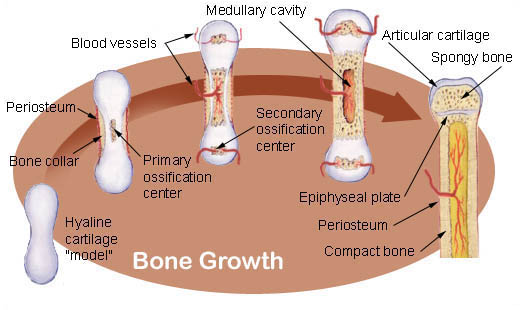Bone resorption begins when the osteoclast attaches to the bone matrixand forms a ruffled membrane see fig. In step four bone remodeling begins.

6 4 Bone Formation And Development Anatomy Physiology
MSCs migration raise as an essential step of bone formation because MSCs initially need to migrate to the bone surface and then contribute in bone formation process although MSCs differentiation into osteogenic cells is also crucial.

. The healing of a bone fracture follows a series of progressive steps. Calcification occurs to form a solid matrix The osteoblast in lacuna is isolated and becomes an osteocyte. Figure 642 Endochondral Ossification.
Once activated the osteoclasts can secrete various enzymes including collagenases that are capable of digesting the mineralized bone and its collagen. It occurs on a continual level inside the body with the broken down bone being replaced by new bone growth. Osteoclasts resorb dead bone while osteoblasts create new bone that replaces the cartilage in the calluses.
Bone resorption is a process in which of minerals and collagen fibers from bone are taken away by osteoclasts. B Internal and external calli form. Calcitonin inhibits osteoclasts action and stimulates osteoblastic activity which allows for increase calcium deposition into bones thus promoting bone formation and bringing blood calcium level back to normal.
Bone ossification or osteogenesis is the process of bone formation. Ca2 and PO43- are then taken up by the osteoclasts and released into the circulation. The bone is formed from connective tissue such as mesenchyme tissue rather than from cartilage.
In step one there is formation of a fracture hematoma. Briefly describe the four parts of an osteon and compare it to trabeculae. There are two types of bone ossification intramembranous and endochondral.
Ridges in periosteum create groove for periosteal blood vessels in step one of bone deposition. C Capillaries penetrate cartilage and. Bone deposition is the addition of minerals and collagen fibers to bone by osteoblasts.
A small blood clot known as a hematoma forms around the fracture site which then attracts molecules called white cells. MSC migration and differentiation are two important physiological processes in bone formation. The process takes two general forms one for compact bone which makes up roughly 80 percent of the skeleton and the other for cancellous bone including parts of the skull the shoulder.
Both is these processes are involved in bone remodelling. Osteogenic cells develop into osteoblasts. During this first step many preosteoclasts mature into osteoclasts which are able to de-mineralize the bone.
When a bones rate of resorption exceeds its rate of replacement it leads to conditions like osteoporosis. Hydroxyapatite crystals are deposited into the bone matrix. Figure 2 Stages in Fracture Repair.
This process begins between the sixth and seventh weeks of embryonic development and continues until about age twenty-five. Bone formation occurs by osteoblasts secreting an organic matrix osteoid and then mineralizing the matrix. However bone deposition involves the deposition of hydroxyapatites while bone resorption involves dissolving of hydroxyapatites.
This process of skeletal change is known as bone remodeling which both protects the structural integrity of the skeletal system and metabolically contributes to the bodys balance of calcium and phosphorus. Calcification of bone occurs when calcium and phosphate ions move out of the blood into the bone tissues. 11 describe the steps in bone resorption.
Endochondral ossification follows five steps. Osteoclastic resorption occurs by secretion of acid and proteolytic enzymes which digest the bone matrix. B Blood vessels on the edge of the cartilage model bring osteoblasts that deposit a bony collar.
The disruption of blood flow to the bone results in the death of bone cells around the fracture. Ossification begins about the third month of fetal life in humans and is completed by late adolescence. Although this varies slightly based on the individual.
The first phase of the fracture healing process starts the moment after bone breaks. A process called bone deposition. Importantly the rate of bone deposition and rate of bone resorption are equal in a healthy individual.
In step three a bony callus is formed. Bone formation also called ossification process by which new bone is produced. Osteoblasts secrete osteoid a composite of collagen chondroitin sulfate and osteocalcin.
Briefly describe the steps in bone resorption. Bone deposition and bone resorption are two major processes of bone remodeling. Development of ossification center.
White cells form part of the bodys defense system. Each of these processes begins with a. The osteoblasts begin formation of matrix.
In step two a fibrocartilaginous callus is formed. A A fracture hematoma forms. The steps in intramembranous ossification are.
Destruction of bone extracellular matrix is a result of bone resorption. Intramembranous ossification mainly occurs during the formation of the flat bones of the skull as well as the mandible maxilla and clavicles. Calluses eventually unite and bone remodeling occurs to complete the healing process.
Bones are not inert structures within the human body. Bone resorptiondissolution of hydroxyapatite produced by the action of osteoclastsfig. They continue to change over the course of a lifespan.
C Cartilage of the calli is replaced by trabecular bone. A Mesenchymal cells differentiate into chondrocytes that produce a cartilage model of the future bony skeleton. 16 Briefly describe the steps in bone deposition.
1918a results in the return of bone calcium and phosphate to the blood. The diagram illustrates repair of a bone fracture. Bone resorption is a process involving the breakdown of bone by specialized cells known as osteoclasts.
Remodeling entails the resorption of old or. At this point the body goes into action right away. It results in the formation of bone extracellular matrix.
In the second step of bone deposition periosteal ridges fuse forming an endosteum-lined tunnel. This process is called bone deposition. During indirect bone healing fracture repair begins with the formation of a hematoma followed by cartilaginous internal and external calluses.

6 4 Bone Formation And Development Anatomy Physiology

Bone Development Boundless Anatomy And Physiology

0 Comments